The Goal
The scientists are using space in the Sanford Underground Research Facility (SURF) in Lead, South Dakota, to work on a project called the Compact Accelerator System for Performing Astrophysical Research (CASPAR). CASPAR uses a low-energy particle accelerator that will allow researchers to mimic nuclear fusion reactions in stars. If successful, their findings could help complete our picture of how the elements in our universe are built. “Nuclear astrophysics is about what goes on inside the star, not outside of it,” said Dan Robertson, a Notre Dame assistant research professor of astrophysics working on CASPAR. “It is not observational, but experimental. The idea is to reproduce the stellar environment, to reproduce the reactions within a star.”
“The idea is to reproduce the stellar environment, to reproduce the reactions within a star.”
SURF is located in the former Homestake Gold Mine, which operated for more than a century extracting ore from hundreds of miles of tunnels, thousands of feet below the earth’s surface. That depth is key to projects like CASPAR. With a keen sense of the irony at play, Robertson explains that researchers must “reproduce the stellar environment” by getting as far away from that environment as possible to reduce the cosmic radiation that constantly bombards the earth and creates “noise” which interferes with sensitive physics experiments.
“When we go underground, there’s a lot of rock above us that’s a mild shielding from cosmic rays,” Robertson said. “Once you get underground, cosmic ray background almost completely disappears.”
It’s a fairly direct rationale for a project that took a winding path to fruition.
Finding a Site
Notre Dame’s involvement with SURF has its origins in a facility called the Deep Underground Science and Engineering Laboratory (DUSEL), planned by the National Science Foundation (NSF) as a complex of laboratories for research in multiple fields: biology, chemistry, geology, as well as physics.
Notre Dame researchers were especially interested in one aspect of the DUSEL concept called DIANA (Dual Ion Accelerators for Nuclear Astrophysics). And with good reason, according to Robert J. Bernhard, the University’s vice president for research. “The nuclear astrophysics community identified DIANA as a priority, and identified Michael Wiescher to lead that facility,” Bernhard said.
Wiescher, the Freimann Professor of Nuclear Physics at Notre Dame, led the planning for the DIANA portion of the NSF proposal. That is, right up until sequestration of federal spending made funding of the project impossible. The NSF would eventually ask Wiescher and Notre Dame to withdraw the DIANA proposal, with hopes of one day revisiting it.
“So the question was, do we just drop it, or do we move ahead?” Wiescher recalls. “And we decided to move ahead, with a smaller scale version.”
Moving ahead with a smaller project allowed the NSF to still be involved, while a coalition of other partners was formed, including the South Dakota School of Mines and Technology, and Colorado School of Mines. The collaborative nature of CASPAR is indicative of a trend in scientific research at large, and especially at Notre Dame, according to Bernhard. For its part, Notre Dame is strategically investing in labs and equipment that serve multiple researchers and collaborative programs.
”Instead of buying equipment for individual labs, we’re directing funding in high performance, shared facilities such as the integrated imaging facility, the center for nano research and technology, the genomics and bioinformatics facility, the mass spectrometry and proteomics facility,” Bernhard said.
That same philosophy is at work at SURF, which, like CASPAR, has its own indirect path to realization. The Homestake Mine was founded after an expedition led by George Armstrong Custer discovered gold in South Dakota’s Black Hills in 1874. Five years later, the Homestake Mining Company began operations, eventually carving out 370 miles of tunnels as deep as 8,000 feet, creating one of the deepest mines in the country. The gold vein was eventually exhausted after producing 1.25 million kilograms of gold in its lifetime (roughly $80 billion at today’s rates), and Homestake shut down in 2001.
The closing of Homestake resulted in an economic and identity crisis for Lead and the surrounding area. However, in addition to its gold mining past, Homestake had a unique astrophysics connection.
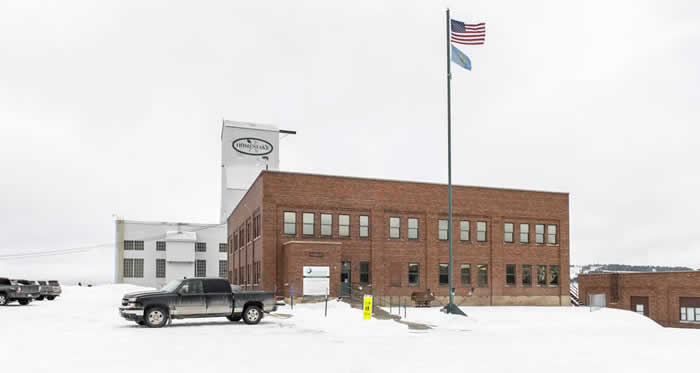
The Sanford Underground Research Facility in Lead, South Dakota still bears the Homestake moniker.
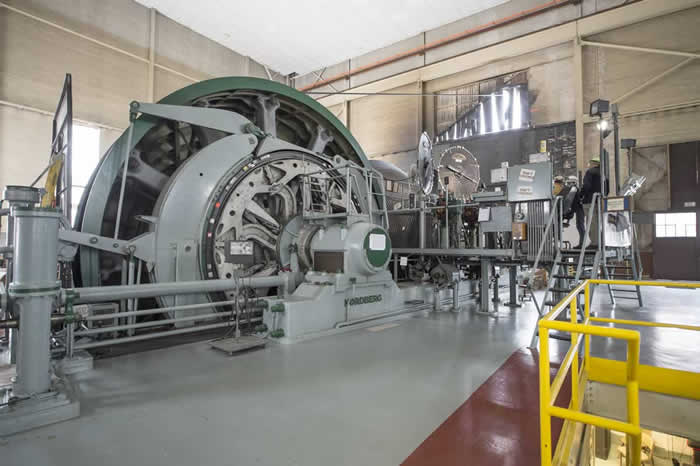
A hoist drum spooling more than 5,000 feet of steel rope lifts and lowers the elevator in the mine shaft.
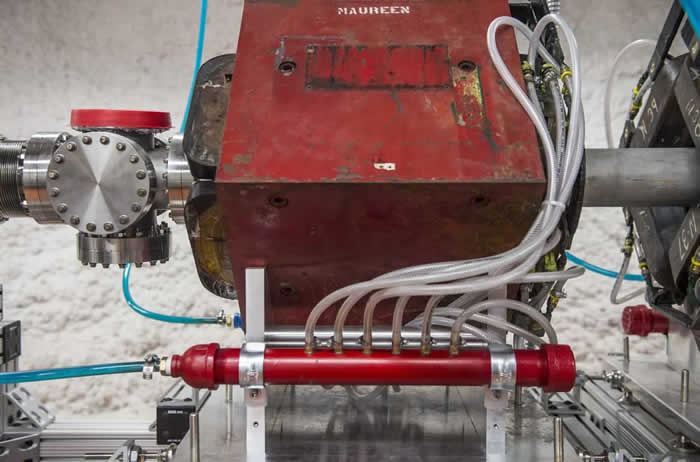
The Compact Accelerator System is modular, to allow for transport down the mine shaft.
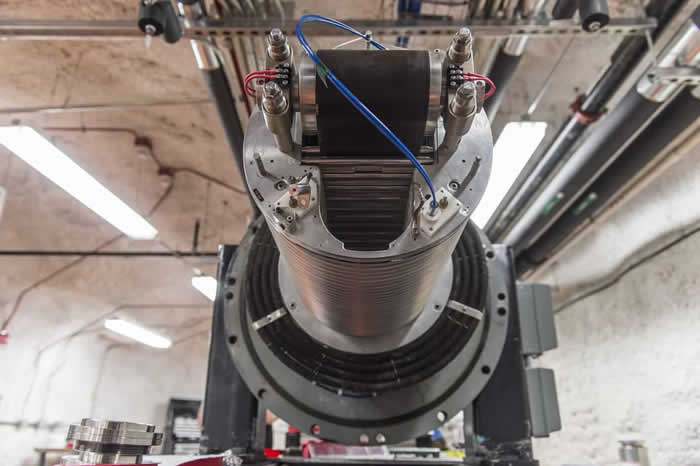
A section of the CASPAR system.
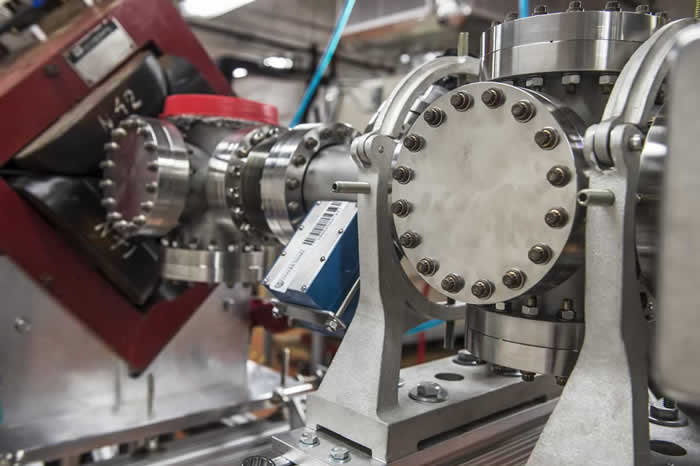
Another portion of the Compact Accelerator System used in CASPAR.
In 1965, Ray Davis, a nuclear chemist from Brookhaven National Laboratory, began building an experiment deep in the Homestake mine with the goal of counting neutrinos, subatomic particles produced in fusion reactions inside stars. In 2002, Davis was awarded a share of the Nobel Prize for Physics for his neutrino work at Homestake.
When Homestake announced it would close the mine, physicists, aware of Davis’ neutrino success, proposed converting it into a deep underground laboratory. In 2004, the South Dakota Legislature created the South Dakota Science and Technology Authority (SDSTA) to work with the scientists proposing the lab. In 2006, Homestake Mining Co. donated the underground mine to the SDSTA. Also in 2006, the SDSTA accepted a $70 million gift from South Dakota philanthropist T. Denny Sanford, who stipulated that $20 million of the donation be used for a Sanford Science Education Center.
Then the real work began, according to Ani Aprahamian, Notre Dame’s Freimann Professor of Experimental Nuclear Physics and a member of SDSTA’s board.
“When you have a mine, it’s just people going under to dig at the rock. It’s dirty, filthy,” Aprahamian said. “This is a laboratory that requires a high level of cleanliness, underground. It’s a little bit more than just building a scientific lab, like you would above ground. So the transformation was quite astounding.”
The first step in that transformation was to pump millions of gallons of water out of the tunnels of the old mine. That task took months. Then came the installation of the power and technology infrastructure required in the roughly 4,400 square feet occupied by CASPAR. Meanwhile, the group of Notre Dame astrophysicists had to devise a way to disassemble and move an accelerator that had been on campus for 10 years to its new underground home.
“We worked in conjunction with the team at SURF so that everything we designed and built at Notre Dame was modular,” said Robertson. “The idea was that we could dismantle every section and bring it down in much smaller pieces and rebuild it from scratch. We packed it all up into two U-Haul vans and dragged it all the way from campus to SURF.”
When it arrived, the equipment was brought down the mine shaft via infrastructure originally designed to move men and minerals, not highly sensitive scientific equipment. Robertson recalls the series of roughly two-mile trips from the surface to the underground lab taking upwards of 45 minutes because of the pace at which the conveyances had to travel with accelerator parts on board.
The Unique Journey to a Unique Lab
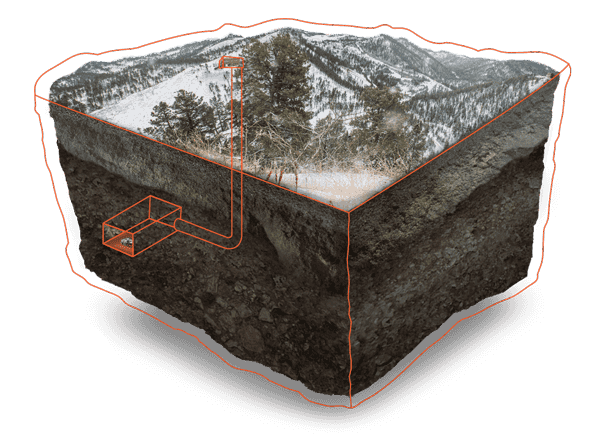
It’s just one of the ways the space’s mining past is meeting its scientific present. Indeed, a visit to CASPAR is unlike a visit to any other laboratory environment. It starts with a comprehensive safety briefing and signing of a series of waivers. Before descending into the mine, one dons overalls, steel-tipped boots, safety goggles and a hard hat and attaches a carbon monoxide detector around the waist. Next, you pick up a gold medallion with a number inscribed on it and enter your name and number on a clipboard. If the medallion is missing at the end of the day, it becomes clear that someone is still underground in the mine. While certainly effective, it’s a fascinating juxtaposition in the highly technical work of exploring the origins of the universe.
The descent into the mine takes place in a cage that, at most, holds 15 people. The approximately mile-long trip takes 10 minutes without lab equipment, which requires a slower pace and more time. Yet even those 10 minutes can seem longer. The only light in the cage is from a headlamp on the cage operator’s hard hat, which briefly illuminates the wood supports and rock pilings framing the shaft.
After the descent, you arrive at what is familiarly called the 4850 Level of SURF. You exit into a surprisingly well-lit area with tunnels, or “drifts” in mining parlance, running right and left. CASPAR is located through the left, mile-long tunnel. It’s a startling experience to emerge through the dark tunnel and enter the pristine, high-tech environs of CASPAR. There, Notre Dame researchers and doctoral students have nearly completed reassembly of the accelerator that was shipped in parts from Notre Dame, like an incredibly complex jigsaw puzzle. Experiments are expected to begin in the summer of 2016.
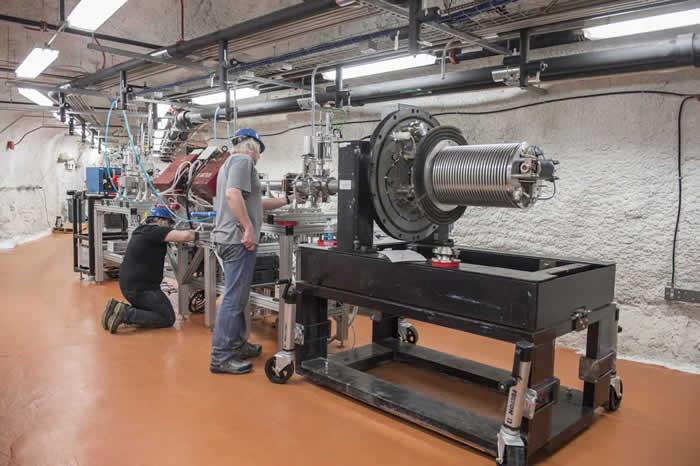
Daniel Robertson, Research Assistant Professor from Notre Dame and Frank Strieder, Associate Professor of Physics from the South Dakota School of Mines and Technology, (right) assemble the Compact Accelerator System.
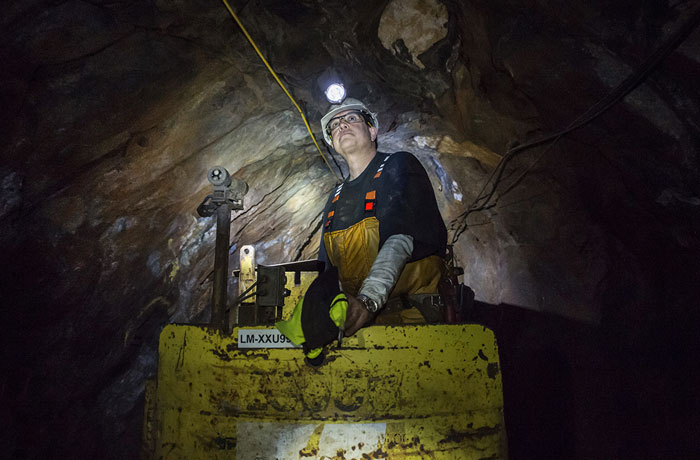
Infrastructure technician and former gold miner Mike Oates drives the train through a mine tunnel 4,850 feet below the surface.
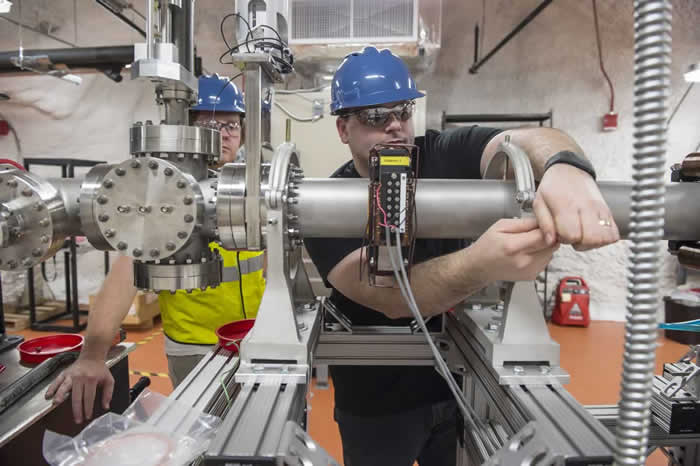
Daniel Robertson, research assistant professor, assembles the Compact Accelerator System.
The groundbreaking scientific breakthroughs the CASPAR researchers are seeking cannot be achieved without the invaluable technical expertise of the former Homestake miners, who were brought back to operate and maintain the mine equipment still being used. The miners and astrophysicists have formed a close working relationship, and Wiescher indicates there is a bond between the two groups that extends beyond just the common workspace.
“Our goal in CASPAR is to measure the evolution of the elements in the stars,” he said. “There are a number of questions that need to be answered, one being the ratio of carbon to oxygen in our universe. That will be determined by one of the reactions we want to measure. But also, we want to understand the buildup of heavy elements. When you look at old stars – those that came to be around the time of the Big Bang – there are very few elements. You can see in younger stars the elements slowly build up, including heavy elements, such as gold.”
In other words, Notre Dame researchers are using a retired gold mine in a town called Lead, to determine what reactions lead to the formation of gold in stars, among other things.
CASPAR is on schedule to be the first such project of its kind to yield results. When it does, Wiescher said the knowledge will have implications across multiple fields of study, most obvious astronomy and the material sciences. Robertson adds that sometimes these kinds of experiments yield other technologies that have broad public familiarity. Nuclear physics experiments have been instrumental in developing MRI and PET scans, for example. While those kinds of outcomes are not an intended goal of projects like CASPAR, Bernhard believes in today’s world they’re nonetheless critical.
“Nationally, there is an increasing expectation that universities will be a vehicle of discovery that will continue to provide the basic foundation that will drive better understanding of our world and our future economy,” Bernhard said. “The CASPAR project is an excellent example of this type of research.”
For now, the precious gold researchers seek is a deeper understanding of our universe. It happens that the best way to do so is to build a deeper lab, where the cosmos can be shut out in hopes of revealing its secrets.